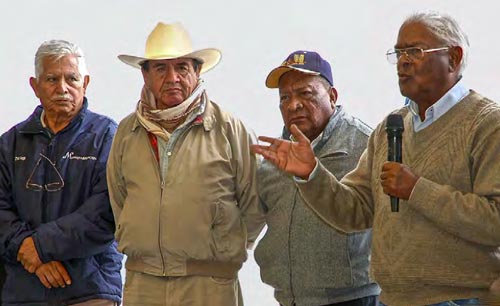A field day was held on 4 September at CIMMYT’s Toluca experiment station to give CIMMYT scientists the opportunity to explain their program objectives and research activities to colleagues who may not have been familiar with their work. Dr. Sanjaya Rajaram, 2014 World Food Prize recipient, and several retired CIMMYT employees who had worked with him also attended. Over 100 current and former staff members attended, with one group receiving presentations in English and the other in Spanish.
The day began with a welcome from Hans Braun, director of the Global Wheat Program (GWP), after which the visitors headed out to the fields where GWP’s David Bonnet and Masahiro Kishi presented the work they are doing with hybrids and wide crosses. The term “wide cross” refers to the practice of crossing modern plant varieties with wild plant relatives, in order to create new varieties with desired characteristics.
A presentation on durum and triticale was given by Karim Ammar, GWP wheat breeder, who explained the importance of the Toluca experiment station, where the last visual check of plants occurs before going to field trial. Carlos Guzman, a post-doctoral fellow at CIMMYT in GWP’s Wheat Quality Laboratory, presented on the different varieties of wheat, their properties and the resulting products. At the end of the presentation, samples of bread and cookies created using CIMMYT wheat were given to participants.
The activities of the Seeds of Discovery (SeeD) project were presented by Sukhwinder Singh, wheat lead for SeeD, and Carolina Saint Pierre, genetic resources (wheat) phenotyping coordinator for SeeD. They explained their work on phenotyping, which involves screening seeds for different accessions, diseases and properties. Pavan Singh, wheat rust pathologist and molecular breeder in the GWP and head of pathology, discussed the various diseases that challenge wheat production today and their locations.

Ravi Singh, wheat breeder in GWP’s Bread Wheat Improvement and Rust, led the presentation on bread wheat, highlighting the fact that 95 percent of wheat farmers grow bread wheat on over 220 million hectares of the world’s farmland. Afterwards, Maria Tattaris, post-doctoral researcher, Mariano Cossani and Gemma Molero, associate scientists, presented on the Wheat Physiology Program and distributed the program’s most recent publications to the visitors.
Michael Mulvaney of the Global Conservation Agriculture (CA) Program (GCAP) presented on the three main principles of CA – minimal tillage, keeping soil covered with organic matter and rotation. He also discussed the economic and ecological benefits farmers can gain from adopting these practices. Lastly, staff members of the Maize Genetic Resources Center spoke on their activities and gave a manual pollination demonstration.
After the presentations, the visiting staff members returned to the Toluca station for a delicious lunch of carne asada and esquites provided by Toluca superintendent Fernando Delgado and his staff. Dr. Rajaram gave a speech during the luncheon, and invited the retired CIMMYT employees in attendance to stand with him as he spoke on CIMMYT’s past and his hopes for its future. “CIMMYT’s greatest strength is its human resources,” he said, and thanked them for their contributions to the Center.
 Capacity development
Capacity development